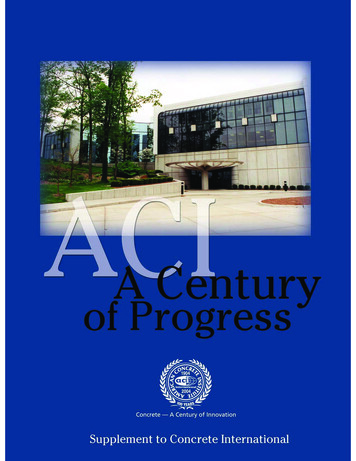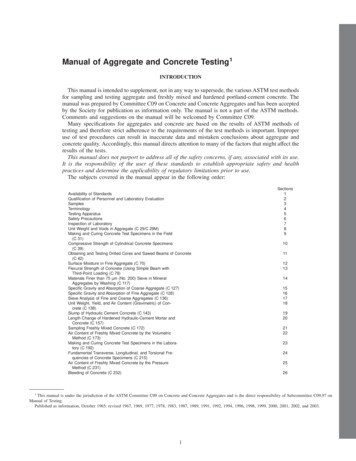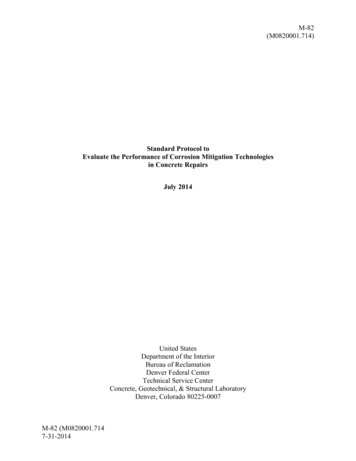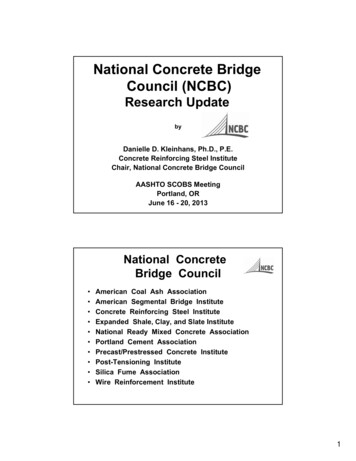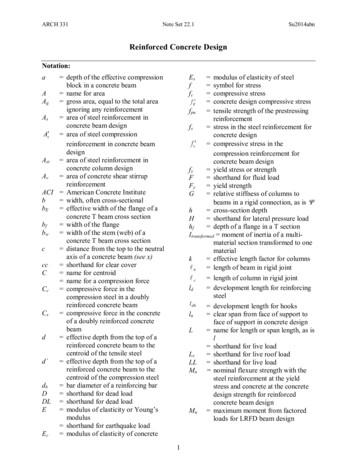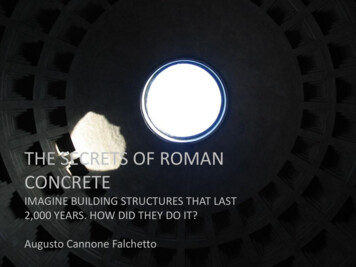
Transcription
THE SECRETS OF ROMANCONCRETEIMAGINE BUILDING STRUCTURES THAT LAST2,000 YEARS. HOW DID THEY DO IT?Augusto Cannone Falchetto
OUTLINE-IntroductionConcrete AqueductsThe Secret Roman RecipeBuildingsConclusions
TREVI FOUNTAIN
CONCRETE AQUEDUCT- 11 Aqueducts – 300 miles 150 – 200 gallons perperson per day- Aqua Virgo 19 B.C. (Jesus Christ was not born!)11 miles from Salone springs- Aqua Claudia- 50 miles – Arcades of arches 60 feet high- · Aqua Alsietina · Aqua Appia · Aqua Augusta(Naples) · Aqua Augusta (Rome) · Aqua Claudia ·Aqua Julia · Aqua Marcia · Aqua Martia · AquaTepula · Aqua Traiana
CONCRETE AQUEDUCTSegoviaAqua Claudia
THE SECRET ROMAN RECIPE Lime-coated mud walls were constructed in central India as early as 2,500B.C. Romans, used it as a sort of stucco covering for mud walls and other crudestructures It is not known exactly when the Romans first began mixing lime withother substances to form concrete a wall of rubble in Pompeii was held together with a firm black pozzolanand lime mortar dating to the late third century before Christ by 199 B.C. the Romans were already using hydraulic concrete to line theharbor works at Puteoli, which indicates a striking degree of sophistication.
THE SECRET ROMAN RECIPE Use of Roman concrete reached its zenith during the reigns of theEmperors Trajan and Hadrian, 98 to 138 A.D. By that time the craftsmen were well trained with many tools and theywere sufficiently educated to attain teamwork. An example of concrete construction from this period is Trajan’s Forum,the forerunner of today’s shopping mall: 150 stores in the middle of oldRome. The ruins of this landmark can still be observed today, including itscenterpiece, the Great Hall, whose vaulted roof is still intact.
THE SECRET ROMAN RECIPETrajan Forum
THE SECRET ROMAN RECIPE The Romans had two distinct types of concrete mortar:binderaggregatewater1 partlime3 partscrushed sand15-20%1 partlime2 partsriver sand15-20%1 part2 partslimeriver sandplus 1 part of tile fragment15-20%1 partlime15-20%2 partspozzolan“DE ARCHITECTVRA”(Vitruvius, II, v, 5)(Vitruvius, II, v, 6)(Vitruvius, II, v, 7)(Vitruvius, v, XII, 8-9)
THE SECRET ROMAN RECIPE Marcus Vitruvius Pollio Vitruvius an engineer and architect for the Emperor Augustus, wrote 10books on architecture and engineering: DE ARCHITECTVRA“there is also a kind of powder which from natural causes producesastonishing results. It is found in the neighborhood of Baiae and in thecountry belonging to the towns round about Mount Vesuvius. Thissubstance, when mixed with lime and rubble, not only lends strength tobuildings of other kinds, but even when piers of it are constructed in thesea, they set hard under water.”“Estetiam genus pulveris quod efficit naturaliter res admirandas. nascitur in regionibusBaianis et in agris municipiorum quae sunt circa Vesuvium montem. quod commixtum cumcalce et caemento non modo ceteris aedificiis praestat firmitatem, sed etiam moles cumstruuntur in mari, sub aqua solidescunt.”
THE SECRET ROMAN RECIPE Pozzolan A siliceous or aluminous material which in itself possesses nocementitious value, but will, in a finely divided form, and in the presenceof moisture, chemically react with calcium hydroxide at ordinarytemperatures to form compounds possessing cementitious properties By using volcanic ash in the place of river sand in their concrete, theRomans were able to mimic the process by which Portland cementchemically bonds lime to clay through the application of heat. But finely divided pozzolan must be amorphous (glassy) to chemicallyreact.
THE SECRET ROMAN RECIPEHow was this possible?Because the volcano Vesuvio had already heated the pozzolan for them!the pozzolan was calcined by the volcano, enabling it to chemically reactwith calcium hydroxide in slaked lime, no heating required.Using pozzolan in such high concentrations, pozzolan can decreaseconcrete porosity, create greater long-term strength, and help to reducethe deleterious effects of alkali aggregate reaction and sulfate attack.
THE SECRET ROMAN RECIPEVolcano Vesuvio
THE SECRET ROMAN RECIPEOther “secrets” Rigid quality control, Low water to cementitious materials ratio, and Expert placement and compaction. the Romans had no knowledge of present-day chemistry, they nonetheless knew how to distinguish a good quality lime and otherconcrete ingredients through empirical observation Vitruvius “We must be careful that it [lime] be burned from stone which,whether soft or hard, is in any case white, and lime made of close-grainedstone of the harder sort will be good in structural parts; lime of porousstone, in stucco.”
THE SECRET ROMAN RECIPEOther “secrets” Low water to cementitious materials ratio and compaction Roman mortar was comparable to a modern-day zero-slump concrete like RCC: so stiff and firm that it would not flow into the spaces between therocks in the aggregate. The Romans even used a special tool called a beetle to tamp it and poundit into place. The Romans also used wooden casting forms,
BUILDINGSCOLOSSEUM
BUILDINGSPantheon
TRIUMPHAL ARCH
BRIDGES
A DARK NIGHT After the emperor Hadrian passed away in 138 A.D., the Romans ceasedbuilding new towns, much less cities. Further the Romans neglected to maintain their infrastructure, a costlymistake that holds lessons for the modern age. The final blow came in 410 A.D. when Alaric the Goth sacked Rome. The world would soon enter a Dark Age, and the miracle of concretewould be lost until 1824, when Joseph Aspdin concocted his first stove-top brew
REFERENCES Storia dell’Architettura Occidentale Zannichelli David Watkin 2000 L'arte di costruire presso i Romani - materiali e tecniche - Ed. Longanesi eC., Jean-Pierre Adam 1988 The Secrets Of Roman Concrete - By Benjamin Herring and Stephani Miller,C O N S T R U C T O R ’s “MAKING THE REALLY GOOD STUFF. ” www.romanconcrete.com Wikipedia Personal Pictures
Aliquasquaestioneshabetis?
THE SECRET ROMAN RECIPE Use of Roman concrete reached its zenith during the reigns of the Emperors Trajan and Hadrian, 98 to 138 A.D. By that time the craftsmen were well trained with many tools and they were sufficiently educated to attain teamwork. An example of concrete




